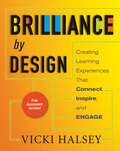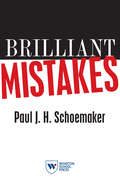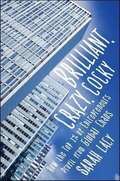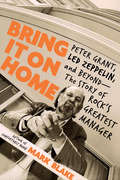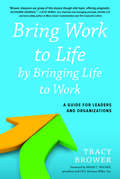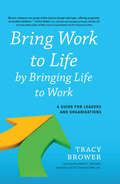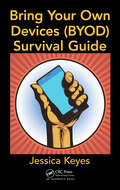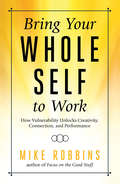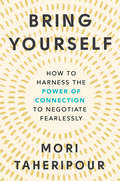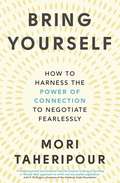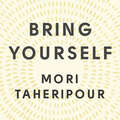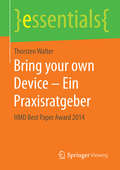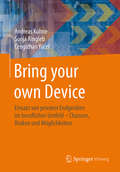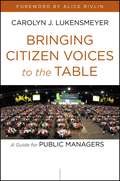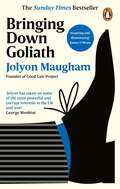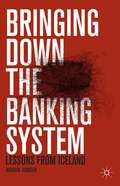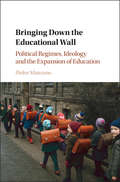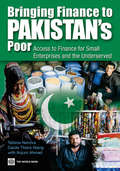- Table View
- List View
Brilliance by Design: Creating Learning Experiences That Connect, Inspire, and Engage
by Vicki HalseyMany subject matter experts are just that, subject matter experts--not experts in the art of teaching, facilitating, or designing. Thousands of authors, trainers, and speakers have great content, but they lack the skills required to convey their content in a way that inspires learners to unleash their brilliance and move the learning to practice.. They often spend 70% of their time on WHAT they are going to teach, and 30% of their time on HOW, when they should be spending 30% on WHAT, and 70% on HOW. Their instructional techniques often are at odds with their message of inclusivity, eagerness for people to learn, and hopes that their content will change lives and organizations. “Brilliance by Design” outlines how to design learning interactions (such as meetings and workshops) that enable people to do their best thinking. Using the tested, signature ENGAGE model, it helps anyone who brings people together for the purpose of learning, problem-solving, or innovating to develop a clear, high-impact training design that unleashes brilliance. It presents a model that enables teachers to analyze learner and teacher needs, create objectives that meet those needs, and incorporate interactive tools that “fire ‘em up,” ensuring all key outcomes are met. To help readers unleash the brilliance in others, this book provides the structure, tools, language, and models needed to create optimal learning experiences from their ideas, practices, models and books. In learning these techniques, readers will achieve powerful outcomes, building communities of learners who share best practices and communicate at a deep and profound level while doing real work.
Brilliant Mistakes: Finding Success on the Far Side of Failure
by Paul J. SchoemakerNamed #1 Best Business Book of 2011, by Patriot-News-PennLive.comIf you have ever flown in an airplane, used electricity from a nuclear power plant, or taken an antibiotic, you have benefited from a brilliant mistake.Each of these life-changing innovations was the result of many missteps and an occasional brilliant insight that turned a mistake into a surprising portal of discovery. In Brilliant Mistakes, Paul Schoemaker, founder and chairman of Decision Strategies International, shares critical insights on the surprising benefits of making well-chosen mistakes.Brilliant Mistakes explores why minimizing mistakes may be the greatest mistake of all, situations when mistakes are most beneficial and when they should be avoided, the counter-intuitive idea that we should deliberately permit errors at times, and how to make the most of brilliant mistakes to improve business results.Brilliant Mistakes is based on solid academic research and insights from Schoemaker's work with more than 100 organizations, as well as his provocative Harvard Business Review article with Robert Gunther, "The Wisdom of Deliberate Mistakes." Schoemaker provides a practical roadmap for using mistakes to accelerate learning for your organization and yourself.
Brilliant, Crazy, Cocky
by Sarah LacyAn unforgettable portrait of the emerging world's entrepreneurial dynamos Brilliant, Crazy, Cocky is the story about that top 1% of people who do more to change their worlds through greed and ambition than politicians, NGOs and nonprofits ever can. This new breed of self-starter is taking local turmoil and turning it into opportunities, making millions, creating thousands of jobs and changing the face of modern entrepreneurship at the same time. To tell this story, Lacy spent forty weeks traveling through Asia, South America and Africa hunting down the most impressive up-and-comers the developed world has never heard of....yet. The individuals profiled in Brilliant, Crazy, Cocky are distinct products of their own cultures, yet they share that same unmistakable cocktail of delusion, ambition, and brilliance that drove Bill Gates, Fred Smith, Donald Trump, and every other iconic American entrepreneur of the last few decades.
Bring It On Home: Peter Grant, Led Zeppelin, and Beyond--The Story of Rock's Greatest Manager
by Mark BlakeThe authorized biography of the most notorious rock manager of all time, Peter Grant, best known for his work with Led ZeppelinPeter Grant is the most famous music manager of all time. Often acknowledged as the "fifth member of Led Zeppelin," Grant's story has appeared in fragments across countless Zeppelin biographies, but none has explored who this brilliant and intuitive manager yet flawed and sometimes dangerous man truly was. No one has successfully captured the scope of his personality or his long-lasting impact on the music business. Acclaimed author and journalist Mark Blake seeks to rectify that.Bring It On Home is the first book to tell the complete uncensored story of this industry giant. With support from Grant's family interviews with Led Zeppelin's surviving band members, and access to Grant's extensive archive and scores of unpublished material, including his never-before-published final interview, Blake sheds new light on the history of Led Zeppelin and on the wider story of rock music in the 1960s and '70s.Full of new insights into Grant's early life as an actor, wrestler, and road manager for rock 'n' roll pioneers Chuck Berry and Little Richard; the formation of Led Zeppelin; his seclusion following the demise of the band; and his recovery from substance abuse, Bring It On Home reveals a man who, after the extraordinary highs and lows of a career in rock 'n' roll, found peace and happiness in a more ordinary life. It is a celebration, a cautionary tale, and a compelling human drama.
Bring Others Along With You: Leading Change with Creativity
by Stewart D. FriedmanThere are bound to be all kinds of what-ifs and resistance when you are beginning to enact a change. If you don't deal with them effectively, they will destroy your initiative. This chapter explores how to find the courage to overcome the obstacles, both internal and external, that leaders face when trying to create meaningful change in their worlds.
Bring Work to Life by Bringing Life to Work: A Guide for Leaders and Organizations
by Tracy BrowerOrganizations accomplish results when they powerfully engage employees and capture their discretionary time. This is more important than ever during this period where employees are facing unprecedented time poverty. Technology has blurred the lines between employees' work and personal lives, and they are faced with the challenges of successfully navigating and integrating work and personal demands. When organizations provide the right benefits, policies, and cultural practices, they win and they serve employees in the process.Using examples and real-world experiences from senior executives and employees at all levels, author Tracy Brower shows readers the importance of work-life supports and how they lead to more engaged and fulfilled employees. Bring Work to Life by Bringing Life to Work is your go-to guide to work-life support, providing easy-to-read strategies for building and implementing your organization's strategies to harness work-life supports, increasing positive impact to your bottom line.
Bring Work to Life by Bringing Life to Work: A Guide for Leaders and Organizations
by Tracy BrowerOrganizations accomplish results when they powerfully engage employees and capture their discretionary time. This is more important than ever during this period where employees are facing unprecedented time poverty. Technology has blurred the lines between employees' work and personal lives, and they are faced with the challenges of successfully navigating and integrating work and personal demands. When organizations provide the right benefits, policies, and cultural practices, they win and they serve employees in the process. Using examples and real-world experiences from senior executives and employees, author Tracy Brower shows readers the importance of work-life supports and how they lead to more engaged and fulfilled employees. Bring Work to Life by Bringing Life to Work is your go-to guide to work-life support, providing easy-to-read strategies for building and implementing your organization's strategies to harness work-life supports, increasing positive impact to your bottom line.
Bring Your Own Devices (BYOD) Survival Guide
by Jessica KeyesWhere end-users once queued up to ask the IT department for permission to buy a new computer or a new version of software, they are now bypassing IT altogether and buying it on their own. From laptops and smartphones to iPads and virtually unlimited software apps, end-users have tasted their freedom and love it. IT will simply never be the same.Bri
Bring Your Whole Self To Work: How Vulnerability Unlocks Creativity, Connection, and Performance
by Mike RobbinsIn today’s work environment, the lines between our professional and personal lives are blurred more than ever before. Whatever is happening to us outside of our workplace —whether stressful, painful, or joyful —follows us into work as well. We may think we have to keep these realities under wraps and act as if we "have it all together." But as Mike Robbins explains, we can work better, lead better, and be more engaged and fulfilled if —instead of trying to hide who we are —we show up fully and authentically.Mike, a sought-after motivational speaker and business consultant, has spent more than 15 years researching, writing, and speaking about essential human experiences and high performance in the workplace. His clients have ranged from Google to Citibank, from the U.S. Department of Labor to the San Francisco Giants. From small start-ups in Silicon Valley to family-owned businesses in the Midwest. From what he’s seen and studied over the years, Mike believes that for us to thrive professionally, we must be willing to bring our whole selves to the work that we do.Bringing our whole selves to work means acknowledging that we’re all vulnerable, imperfect human beings doing the best we can. It means having the courage to take risks, speak up, have compassion, ask for help, connect with others in a genuine way, and allow ourselves to be truly seen. In this book, Mike outlines five principles we can use to approach our own work in this spirit of openness and humanity, and to help the people we work with feel safe enough to do the same, so that the teams and organizations we’re a part of can truly succeed."This book will offer you insights, ideas, and tools to inspire you to bring all of who you are to the work that you do —regardless of where you work, what kind of work you do, and with whom you do it. And, if you’re an owner, leader, or just someone who wants to have influence on those around you —this book will also give you specific techniques for how to build or enhance your team’s culture in such a way that encourages others to bring all of who they are to work."
Bring Yourself: How to Harness the Power of Connection to Negotiate Fearlessly
by Mori TaheripourA look at how relationships can drive successful negotiation, from an award-winning faculty member at the Wharton School of Business.Contrary to conventional wisdom about what makes a good negotiator - namely, being aggressive and unemotional - in Bring Yourself, Taheripour offers a radically different perspective. In her own life, and in her more than 15 years of experience teaching negotiation, she's found that the best negotiators are empathetic, curious, and present. The essence of bargaining isn't the transaction, but the conversation and human connection. It is when we bring our whole, authentic selves to the table that we can advocate for ourselves fearlessly and find creative solutions that benefit everyone.Taheripour has seen the power of this mindset shift firsthand. In her consulting, her classes at Wharton, and in her work teaching negotiation for the Goldman Sachs 10,000 Small Businesses program, her students and clients experience personal breakthroughs as they face the fears and false narratives that held them back. Bring Yourself explains how our pressure points, personal experience, and even our cultural expectations can become roadblocks to finding common ground, and it offers essential strategies to move beyond them and open our minds. Taheripour argues that regardless of our own perceived ability to negotiate, we must have the courage to engage because bargaining plays a crucial role in every aspect of our lives. We negotiate boundaries with our parents and partners, bedtimes with our kids, and even with ourselves every time we make a pros and cons list to weigh a major decision. Negotiation is how we problem solve and how we find our voice. With eye-opening and empowering stories throughout, Bring Yourself helps readers gain the confidence they need to achieve their goals in work and in life. Timely and provocative, this paradigm-shifting book can transform our world and the way we work together.
Bring Yourself: How to Harness the Power of Connection to Negotiate Fearlessly
by Mori TaheripourContrary to conventional wisdom about what makes a good negotiator - namely, being aggressive and unemotional - in Bring Yourself, Mori Taheripour offers a radically different perspective. In her own life, and in her more than fifteen years of experience teaching negotiation, she has found that the best negotiators are empathetic, curious and present. The essence of bargaining isn't the transaction, but rather the conversation and human connection. It is when we bring our whole, authentic selves to the table that we can advocate for ourselves fearlessly and find creative solutions that benefit everyone.Bring Yourself explains how your pressure points, personal experience and even your cultural expectations can become roadblocks to finding common ground, and it offers essential strategies to move beyond them and open your mind. With eye-opening and empowering stories throughout, Bring Yourself helps readers gain the confidence they need to achieve their goals in work and in life. Timely and provocative, this paradigm-shifting book can transform our world and the way we work together.
Bring Yourself: How to Harness the Power of Connection to Negotiate Fearlessly
by Mori TaheripourContrary to conventional wisdom about what makes a good negotiator - namely, being aggressive and unemotional - in Bring Yourself, Mori Taheripour offers a radically different perspective. In her own life, and in her more than fifteen years of experience teaching negotiation, she has found that the best negotiators are empathetic, curious and present. The essence of bargaining isn't the transaction, but rather the conversation and human connection. It is when we bring our whole, authentic selves to the table that we can advocate for ourselves fearlessly and find creative solutions that benefit everyone.Bring Yourself explains how your pressure points, personal experience and even your cultural expectations can become roadblocks to finding common ground, and it offers essential strategies to move beyond them and open your mind. With eye-opening and empowering stories throughout, Bring Yourself helps readers gain the confidence they need to achieve their goals in work and in life. Timely and provocative, this paradigm-shifting book can transform our world and the way we work together.
Bring the Outside In: Increasing True Urgency by Winning Hearts and Minds
by John P. KotterOrganizations of any size or age tend to be too internally oriented. The disconnect between what insiders see, feel, and think, on the one hand, and external opportunities and hazards, on the other, can be astonishing. This inside-outside gap always reduces an organization's sense of urgency, and must be diminished if organizations hope to implement change successfully.
Bring your own Device - Ein Praxisratgeber: HMD Best Paper Award 2014 (essentials)
by Thorsten WalterThorsten Walter beschreibt die technischen und juristischen Fallstricke sogenannter ,,Bring your own device"-Modelle und stellt die arbeitsrechtlichen Regelungsinstrumente für den Umgang mit BYOD vor. Darüber hinaus werden die verschiedenen technischen Lösungen zur Umsetzung von BYOD im Unternehmen in leicht verständlicher Form einander gegenübergestellt. Der Autor gibt praktische Empfehlungen zur Gestaltung von Regelungen in Nutzungsvereinbarungen.
Bring your own Device: Einsatz von privaten Endgeräten im beruflichen Umfeld – Chancen, Risiken und Möglichkeiten
by Andreas Kohne Sonja Ringleb Cengizhan YücelDas Buch betrachtet das Thema BYOD (Bring your own Device) ganzheitlich - ausgehend von einer Mobile-Strategie im Unternehmen werden alle relevanten Aspekte wie rechtliche Rahmenbedingungen, Sicherheitsrisiken und deren Behandlung, technische Voraussetzungen (Software, IT-Infrastruktur, Support), Einführungs- und Betriebskosten, Erreichbarkeit und Collaboration sowie soziale Aspekte, Unternehmenspolitik und die Implementierung von BYOD beleuchtet. Damit wird dem zunehmenden Trend zur Nutzung von privaten, mobilen Endgeräten im beruflichen Umfeld Rechnung getragen. Praxisnah befassen sich die Autoren mit Problemen und Fragestellungen rund um die Integration von privaten Endgeräten in die IT-Infrastruktur des Arbeitgebers und liefern konkrete Herangehensweisen, Empfehlungen und Best-Practices für die Planung, Prüfung und Umsetzung einer BYOD -Strategie. Das Buch hilft allen, die eine Einführung von BYOD in ihrem Betrieb prüfen, zu einem umfassenden Verständnis von Chancen und möglichen Risiken, aber auch von Alternativen zu gelangen.
Bringing Adam Smith into the American Home: A Case Against Home Ownership
by John Tamny Jack RyanGet ready to have everything you&’ve ever believed about housing and homeownership challenged.In Bringing Adam Smith into the American Home, authors Jack Ryan and John Tamny make a powerful case that the purchase of a home slows wealth attainment—rendering owners immobile in ways that further restrain their wealth chances—and that the act of homeownership deprives owners of the time and ability to do what they do best, which further dampens individual economic achievement.Thanks to the residential real estate pricing cartel, homeownership has become so costly that it has erected wildly expensive barriers to the very mobility that powers so much individual prosperity. As the cartel prospers, homebuyers and sellers alike suffer its rigidity.Ryan and Tamny call for the evisceration of realtor commissions—the only price in all of capitalism that has not come down even a little over the decades despite capitalism&’s brilliant track record of bringing down the price of everything. Ryan, owner of a national residential realty business, recognizes that the very commissions realtors cling to are paradoxically harming them, all the while discreetly but powerfully shrinking prosperity for everyone else.In a book chock-full of insights from Adam Smith, author of the greatest economics book ever written, Ryan and Tamny make their highly original argument available for all as they reveal the truth about the housing market and homeownership.
Bringing Citizen Voices to the Table
by Carolyn J. LukensmeyerThis important resource offers seven field-tested strategies for public managers to help them maximize citizen engagement as they implement the President's Open Government Directive. The Core Strategies for Citizen Engagement are: Establish Links to Decision-Makers; Ensure Demographic Diversity; Create Opportunities for Informed Participation; Maximize Tools of Facilitated Deliberation; Discover Shared Priorities; Establish Clear Recommendations for Action; and Sustain Citizen Engagement. The book includes project and leadership case studies from major federal agencies that elucidate the seven strategies in the context of real-world issues and challenges.
Bringing Data and Information to the Marketplace: Content Providers--Finding the Right Strategy
by Thomas C. RedmanThose trying to bring data and information to market face daunting challenges such as the ease with which data can be copied and resold and the fact that the market for any particular piece of data may be very small. This chapter poses a series of questions that aim to help managers, especially those responsible for strategy, customer-facing marketing, sales or service, and product enhancement, to explicitly think through each of the ways content providers can bring data and information to market and begin to focus on what is right for their organization.
Bringing Data and Information to the Marketplace: Facilitators
by Thomas C. RedmanFacilitators help others use data and information more effectively, and some even enable businesses to conceptualize their processes and organizations in entirely new ways. Escalating demands for content are driving escalating demands for facilitation. In addition to describing the many benefits facilitators can provide, this chapter also looks at data mining in detail. Deriving advantage from data mining is fraught with difficulty, but the risk of being left behind is too great.
Bringing Digital to Wimbledon
by John T. Gourville David J. ArnoldIt was mid-December, 2016 as Alexandra (Alex) Willis read with satisfaction that The All England Lawn Tennis & Croquet Club (AELTC) had won yet another award for its use of social media to reach its fan base. As the organizer and host of "The Championships, Wimbledon," the oldest of tennis's four Grand Slams, the AELTC prided itself on tradition and decorum. Widely regarded as the most prestigious professional tennis tournament in the world and contested each year over two weeks in late June and early July, Wimbledon, in many ways, had changed little over the years. Its showcase venue the 15,000 seat "Centre Court," complete with a "Royal Box" was built in 1926. Slazenger had been the official and only supplier of tennis balls since 1902. A strictly enforced ban on any player clothing other than white dated back to the 1800s. And, whereas other tournaments referred to their Men's and Women's Championships, at Wimbledon, these events were referred to as the Gentlemen's and Ladies' Championships. It was against this "steeped-in-tradition" background that Willis, hired by Wimbledon in 2012 and promoted to Head of Digital and Content in 2015, had to figure out the proper role for digital and social media at Wimbledon. The motivation behind the push into digital was one of communicating and engaging with fans and potential fans around the world, as noted by Richard Lewis, Chief Executive of the AELTC.
Bringing Discipline to Project Management
by Jeffrey Elton Justin RoeHow many projects in your organization have come in on time and on budget? If you're like most senior managers, the answer is likely to be none, no matter how many data-management systems, team-training programs, project-management software packages, or best practices you've been using. Are the project delays and cost overruns inescapable? One business thinker who says no is Eliyahu M. Goldratt. In his widely read novel The Goal, Goldratt pioneered the theory of constraints as a solution for factories struggling with production delays. Now, in Critical Chain, he extends the theory to the realm of project management. Whether a production process or a new-product-development project is at issue, the theory tells managers not to improve each step in the process but instead to focus on the bottlenecks, or constraints, that keep the process from increasing its output. Reviewers Jeffrey Elton and Justin Roe, consultants at Integral Inc., believe the theory works well for project managers dealing with individual projects. But they argue that senior managers need to take a broader perspective into account in order to manage a portfolio of all but the most innovative projects. And they question whether even properly focused managers can easily overcome the many balkanizing pressures that projects, in all their uncertainty, often fall prey to. To handle such pressures, companies also need talented leaders--a "constraint" that many will have difficulty overcoming.
Bringing Down Goliath: How Good Law Can Topple the Powerful
by Jolyon Maugham*The Sunday Times Bestseller*'Inspiring and illuminating' JAMES O'BRIENPicked as a 2023 highlight by the Guardian---------------Our legal system often feels like it only works for the rich and powerful. But we can fight back.Jolyon Maugham KC founded Good Law Project in 2017 with the belief that the law can also put power into the hands of ordinary people. Already the largest legal campaign group in the UK, Good Law Project is shining light into corners the establishment would rather keep dark – from the failures of Brexit to the still-developing PPE scandal, to the tax arrangements of business giants like Uber.In Bringing Down Goliath, Jolyon Maugham KC reveals the story behind these landmark cases and the hidden fault lines of our judicial system. He offers an empowering, bold new vision for how the law can work better for all of us in the fight against injustice.
Bringing Down The Banking System
by Gudrun JohnsenThe combined collapse of Iceland's three largest banks in 2008 is the third largest bankruptcy in history and the largest banking system collapse suffered by any country in modern economic history, relative to GDP. How could tiny Iceland build a banking system in less than a decade that proportionally exceeded Switzerland's? Why did the bankers decide to grow the system so fast? How did businesses tunnel money out of the banking system? And why didn't anybody stop them? Bringing Down the Banking System answers these questions. Gudrun Johnsen, Senior Researcher with Iceland's Special Investigation Commission, tells the riveting story of the rise and fall of the Icelandic banking system, describes the Commission's findings on the damaging effects of holding company cross-ownership, and explains what we can learn from it all.
Bringing Down the Educational Wall: Political Regimes, Ideology, and the Expansion of Education
by Dulce ManzanoBringing Down the Educational Wall studies the causes of educational expansion in a global sample of developing and developed countries from 1960 to 2005. The book explores how the interaction between the economic context of nations (economic development and inequality) and political factors (the type of political regime and the ideology of dictatorships) influences countries' educational outcomes. The book's main contributions are the exploration of ideological differences between autocratic regimes and the tracing of changes in different parts of the income distribution, which accounts for education expanding to broad sectors of the population. Bringing Down the Educational Wall introduces a new database on the ideology of dictatorships and uses quantitative methods and case analyses to test its theoretical arguments. This work will help students in comparative politics and political economy courses to develop their understanding of redistributive policies and the effects of political factors on the expansion of education.
Bringing Finance to Pakistan's Poor: Access to Finance for Small Enterprises and the Underserved
by Cecile Thioro Niang Tatiana Nenova Anjum AhmadAlthough access to financing in Pakistan is expanding quickly, it is two to four times lower than regional benchmarks. Half of Pakistani adults, mostly women, do not engage with the financial system at all, and only 14 percent have access to formal services. Credit for small- and medium-size enterprises is rationed by the financial system. The formal microfinance sector reaches less than 2 percent of the poor, as opposed to more than 25 percent in neighboring countries. Yet it is the micro- and small businesses, along with remittances, that help families escape the poverty trap and participate in the economy. 'Bringing Finance to Pakistan's Poor' is based on a pioneering and comprehensive survey and dataset that measures the access to financial products by Pakistani households. The survey included 10,305 households in all areas of the country, excluding the tribal regions. The accompanying CD contains summary statistics. The authors develop a picture of access to and usage of financial services across the country and across different population groups, and they identify policy and regulatory priorities. Reform measures in Pakistan have been timely, but alone are not enough; financial institutions have lagged behind in adopting technology, segmenting customer bases, diversifying products, and simplifying processes and procedures. Gender bias and low levels of financial literacy remain barriers, as is geographical remoteness. However, the single strongest cause of low financial access is lack of income-not location, education, or even gender. 'Bringing Finance to Pakistan's Poor' will be of great interest to readers working in the areas of business and finance, economic policy, gender and rural development, and microfinance.
